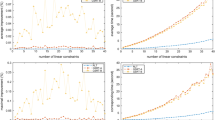Abstract
The convex hull relaxation (CHR) method (Albornoz in Doctoral Dissertation, 1998, Ahlatçıoğlu in Summer paper, 2007, Ahlatçıoğlu and Guignard in OPIM Dept. Report, 2010) provides lower bounds and feasible solutions on convex 0–1 nonlinear programming problems with linear constraints. In the quadratic case, these bounds may often be improved by a preprocessing step that adds to the quadratic objective function terms that are equal to 0 for all 0–1 feasible solutions yet increase its continuous minimum. Prior to computing CHR bounds, one may use Plateau’s quadratic convex reformulation (QCR) method (2006), or one of its weaker predecessors designed for unconstrained problems, the eigenvalue method of Hammer and Rubin (RAIRO 3:67–79, 1970) or the method of Billionnet and Elloumi (Math. Program, Ser. A 109:55–68, 2007). In this paper, we first describe the CHR method, and then present the QCR reformulation methods. We present computational results for convex GQAP problems.
Similar content being viewed by others
References
Ahn, S. (1997). On solving some optimization problems in stochastic and integer programming with applications in finance and banking. Ph.D. dissertation, University of Pennsylvania.
Ahlatçıoğlu, A. (2007). The convex hull relaxation for nonlinear integer programs with linear constraints. Summer paper, OPIM Dept., Univ. of Pennsylvania. Now subsumed by Ahlatçıoğlu and Guignard.
Ahlatçıoğlu, A., & Guignard, M. (2007). The convex hull relaxation for nonlinear integer programs with linear constraints. OPIM Department Report (revised 2008).
Ahlatçıoğlu, A., & Guignard, M. (2010). The convex hull relaxation (CHR) for convex and nonconvex MINLP problems with linear constraints. OPIM Dept. Report, Univ. of Pennsylvania.
Albornoz, V. (1998). Diseño de modelos y algoritmos de optimización robusta y su aplicación a la planificación agregada de la producción. Doctoral Dissertation, Universidad Catolica de Chile, Santiago, Chile.
Billionnet, A., & Elloumi, S. (2007). Using a mixed-integer quadratic programming solver for the unconstrained quadratic 0–1 problem. Mathematical Programming, Series A, 109, 55–68.
Billionnet, A., Elloumi, S., & Plateau, M.-C. (2008). Quadratic 0–1 programming: tightening linear or quadratic convex reformulation by use of relaxations. RAIRO. Recherche Opérationnelle, 42, 103–121.
Billionnet, A., Elloumi, S., & Plateau, M.-C. (2009). Improving the performance of standard solvers for quadratic 0–1 programs by a tight convex reformulation: the QCR method. Discrete Applied Mathematics, 157, 1185–1197.
Contesse, L., & Guignard, M. (1995). An augmented Lagrangean relaxation for nonlinear integer programming solved by the method of multipliers, Part I, Theory and algorithms. Working Paper, OPIM Department, University of Pennsylvania, latest revision 2009.
Frank, M., & Wolfe, P. (1956). An algorithm for quadratic programming. Naval Research Quarterly, 3(1–2), 95–109.
Geoffrion, A. M. (1974). Lagrangean relaxation for integer programming. Mathematical Programming Studies, 2, 82–114.
Guignard, M. (1994). Primal relaxation in integer programming. VII CLAIO Meeting, Santiago, Chile, 1994, also Operations and Information Management Working Paper 94-02-01, University of Pennsylvania.
Guignard, M. (2003). Lagrangean relaxation. Top, 11(2), 151–228.
Guignard, M. (2007a). Extension to the Plateau convexification method for nonconvex quadratic 0–1 programs. OPIM Department Research Paper 07-09-21, University of Pennsylvania.
Guignard, M. (2007b). A new, solvable, primal relaxation for nonlinear integer programming problems with linear constraints. Optimization Online, http://www.optimization-online.org/DB_HTML/2007/10/1816.html, also Operations and Information Management Working Paper, University of Pennsylvania.
Hammer, P. L., & Rubin, A. A. (1970). Some remarks on quadratic programming with 0–1 variables. RAIRO, 3, 67–79.
Hearn, D. W., Lawphongpanich, S., & Ventura, J. A. (1987). Restricted simplicial decomposition: computation and extensions. Mathematical Programming Studies, 31, 99–118.
Michelon, P., & Maculan, N. (1992). Solving the Lagrangean dual problem in integer programming. Report #822, Departement d’Informatique et de Recherche Operationnelle, University of Montreal.
Pessoa, A. A., Hahn, P. M., Guignard, M., & Zhu, Y.-R. (2010). Algorithms for the generalized quadratic assignment problem combining Lagrangean decomposition and the Reformulation-Linearization Technique. European Journal of Operational Research, 206, 54–63.
Plateau, M. C. (2006). Reformulations quadratiques convexes pour la programmation quadratique en variables 0–1. Doctoral Dissertation, Laboratoire Cedric, CNAM, France.
Von Hohenbalken, B. (1977). Simplicial decomposition in nonlinear programming algorithms. Mathematical Programming, 13, 49–68.
Author information
Authors and Affiliations
Corresponding author
Additional information
M. Guignard was partially supported under NSF Grant DMI-0400155.
Rights and permissions
About this article
Cite this article
Ahlatçıoğlu, A., Bussieck, M., Esen, M. et al. Combining QCR and CHR for convex quadratic pure 0–1 programming problems with linear constraints. Ann Oper Res 199, 33–49 (2012). https://doi.org/10.1007/s10479-011-0969-1
Published:
Issue Date:
DOI: https://doi.org/10.1007/s10479-011-0969-1




